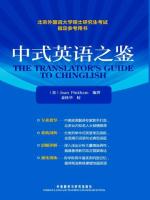Unveiling the Mysteries of Chinglish:
用户826330
In the realm of English language learning and translation,
"Chinglish" stands as a common yet perplexing challenge. The
Translator's Guide to Chinglish, penned by Joan Pinkham, a seasoned
American translator with extensive experience in refining Chinese
translators' English works, serves as an illuminating roadmap to
navigate and overcome these linguistic hurdles. The book is
meticulously organized into three main sections. The first part delves
into "Excessive Words," meticulously analyzing issues such as
redundant nouns and verbs, unnecessary modifiers, and redundant
synonyms. For example, the Chinese phrase "make an
improvement" is often translated directly into English, but the
more concise and natural expression is simply "improve."
Through such examples, Pinkham highlights the stark differences in word
usage between Chinese and English, helping readers develop a keener
sense of concise and idiomatic English expression. The second
section focuses on "Sentence Structure," exploring six key
aspects including "Noun Inflation," pronoun - antecedent
agreement, and the proper placement of phrases and clauses. Take
"Noun Inflation" as an example. In Chinese, it is common to
nominalize verbs, like "the realization of modernization."
However, in English, a more straightforward and natural way is
"modernize." Pinkham's in - depth analysis, accompanied by
numerous real - life examples, equips readers with the tools to
restructure sentences and align them with native English thinking
patterns. The final section offers practical examples and exercise
answers, enabling readers to solidify their understanding and apply the
learned concepts. The carefully designed exercises, which progress from
easy to difficult, effectively enhance readers' ability to identify and
rectify Chinglish in their own writing and translation. This book
has been a paradigm - shifting experience for me. It has made me realize
that Chinglish is not merely about grammatical mistakes; it is deeply
rooted in the divergence of Chinese and English thought processes.
Chinese often relies on implicit semantic connections, while English
emphasizes explicit logical links through conjunctions and other
structural elements. Ignoring these differences inevitably leads to
Chinglish. Before reading this book, I mistakenly believed that complex
and elaborate language equated to proficiency. Now, I understand that
clarity and adherence to native language norms are the hallmarks of good
English. From a practical perspective, The Translator's Guide to
Chinglish is an indispensable resource. For students, it can
significantly improve performance in writing and translation tasks, both
in exams and in daily communication. For professional translators, it
serves as an essential reference book, enhancing the quality and
authenticity of their translations. Admittedly, the book has its
limitations. Given its publication date, some examples may seem a bit
outdated in the context of contemporary language use. Additionally, it
mainly focuses on Chinglish in formal writing, with relatively less
coverage of colloquial Chinglish. Nevertheless, these minor flaws do not
overshadow its status as a classic in English language learning and
translation. In conclusion, The Translator's Guide to Chinglish is a
remarkable and practical guide. Through its detailed analysis, abundant
examples, and systematic presentation, it empowers readers to break free
from the constraints of Chinglish and embrace more natural and
proficient English expression. For anyone struggling with Chinglish,
this book is a highly recommended companion on the journey to mastering English.



 京公网安备 11010802032529号
京公网安备 11010802032529号